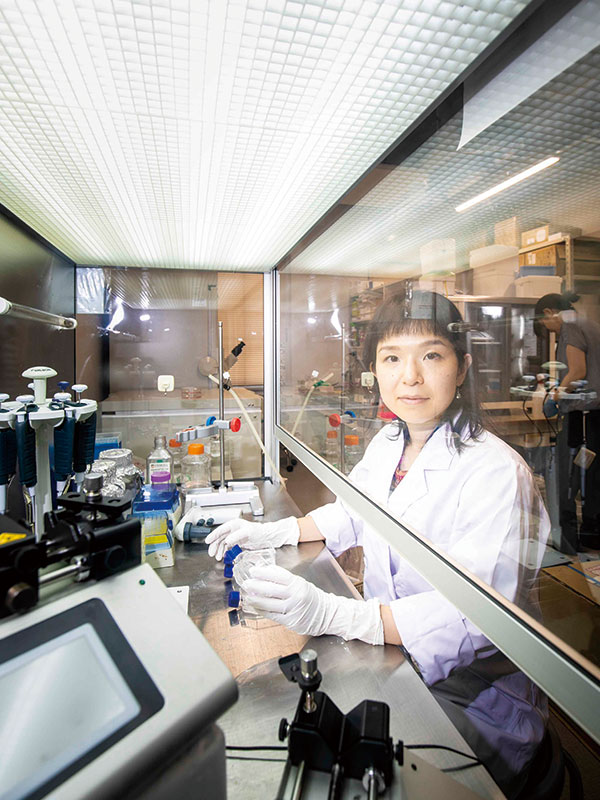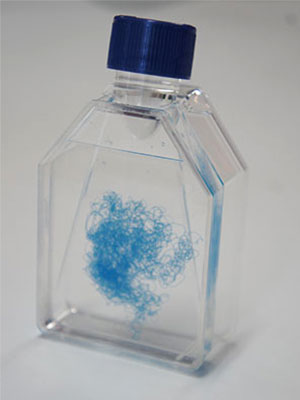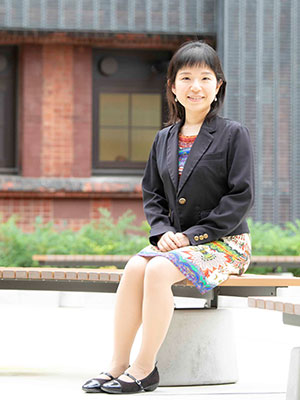Making “cell fiber” technology as commonplace as bubble tea

UTokyo 30s
Up-and-coming young entrepreneurs
Of the more than 350 University of Tokyo spin-off ventures, we have chosen to feature those by seven energetic young entrepreneurs in their 30s. Four of these companies are located in the venture support facilities on the Hongo Campus, one in the support facilities on the Kashiwa Campus, and one each in the Tokyo neighborhoods of Otemachi and Gotanda. How do these young people go about their daily work, and what kind of people are they? A few glimpses are presented here.
| Three-dimensional cell tissue development |
Making “cell fiber” technology as commonplace as bubble tea


Inspired to take up life sciences by Osamu Tezuka’s manga “Black Jack,” Aki Adachi studied tissue engineering in a master’s program. After gaining experience in sales at an IT company and a bio venture, she returned to her former laboratory, where she provided research support. The recognition she received for her work there led to her becoming the CEO of a spin-off venture from the laboratory.
Still in her early thirties, Adachi has so far led a life full of twists and turns, with many ups and downs along the way. Her experience in private companies, however, including sales-related work, which was not necessarily her first choice, prepared Adachi for her current job as CellFiber CEO .
Upon graduation from the Faculty of Science and Engineering of Waseda University, she advanced to UTokyo’s Graduate School of Arts and Sciences. Professor Shoji Takeuchi’s research in the Biohybrid System Laboratory, which aims to discover new ways of making things by applying micro- and nano-device technology in a fusion of life sciences and engineering, was a perfect fit for Adachi. After completing the master’s program, however, she struggled on the job market, ending up in working in sales even though she had been seeking a technical job. Adachi says she was afraid her career might have hit a dead end.
Returning to the Takeuchi Lab in the autumn of 2014 with the intent of doing more technical work, she served as a research administrator, filling out application forms and planning science exhibits for the general public, among other tasks. It was not long before talk came up about starting a company to apply research results to industry, for which Adachi found herself singled out.
“People like postdoc researchers hope to stay on in the academic world. I was told, however, that with my experience in the private sector and also my knowledge about research, I was suited to be a company president. As I was not the type of person who takes a leading role in getting people to do things, I had my doubts; but in the end, I decided to give it a try rather than endlessly mull it over.”
Launched in April 2015 at the Institute of Industrial Science on the Komaba Campus, CellFiber’s strength is technology for forming fiber-shaped tissue by culturing cells in gel tubes just half the diameter of a human hair. Cells can be cultured in a three-dimensional environment similar to an in vivo one, efficiently harvesting large amounts of cells with their original functions preserved intact for a long time. For example, cell transplantation therapy for persons with spinal cord injuries, a treatment which has been garnering attention recently, is hampered by the extremely high cost per person. If cell fiber technology can improve the efficiency of cell culturing, more patients will be able to undergo this treatment.
Moreover, since substances produced by cells can be recovered efficiently, it would be technically feasible to utilize them also as raw materials for pharmaceuticals, cosmetics and food. In fact, Adachi says that in the future she would like to see the spread of cell fiber technology to food and other familiar forms in addition to pharmaceuticals. “For example, putting lactic acid bacteria into fibers and making the fibers edible in a visible form, or putting them in drinks like bubble tea....”
If Adachi’s ambitions are realized, the day may come when her own child, born just last year, will be able to enjoy a probiotic milk drink infused with cell fibers made by her mother.
| Q & A | |
|---|---|
| What activity were you really into as a student? | “I was in the ski club. I loved the Pippu municipal ski area in Hokkaido.” |
| We heard that you like to read. What do you recommend from those you’ve read recently? | “Shiki by Fuyumi Ono, and Greg Egan’s Permutation City. |
| What picture book would you like to read to your child? | “Perhaps that would be Papa, Please Get the Moon for Me and other works by Eric Carle.” |
| Which entrepreneur do you see as a role model? | "Mitsuru Izumo, of Euglena. I see him as someone who has not forgotten the researcher spirit.” |


* This article was originally printed in Tansei 39 (Japanese language only). All information in this article is as of September 2019.



 Aki Adachi
Aki Adachi


